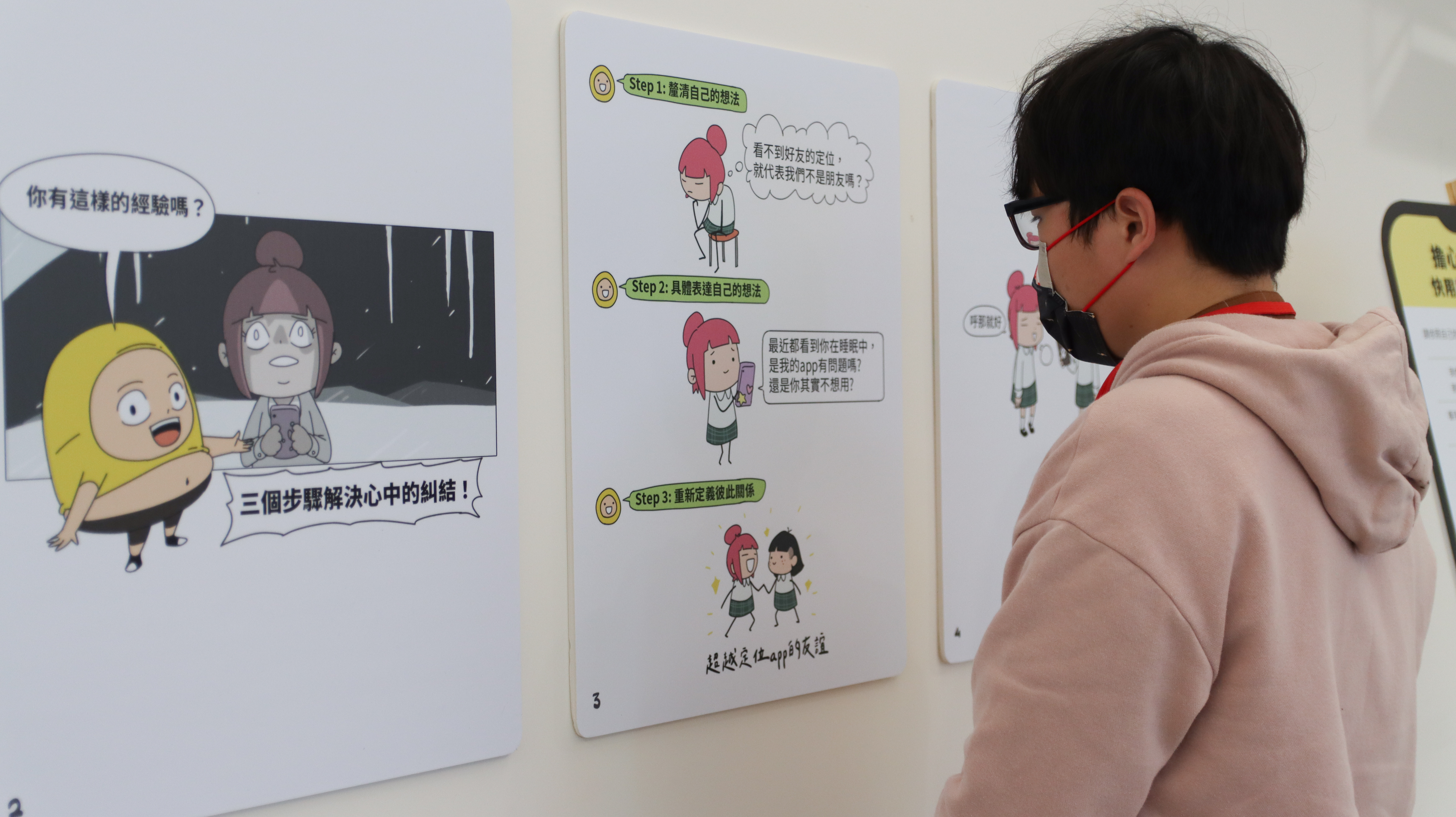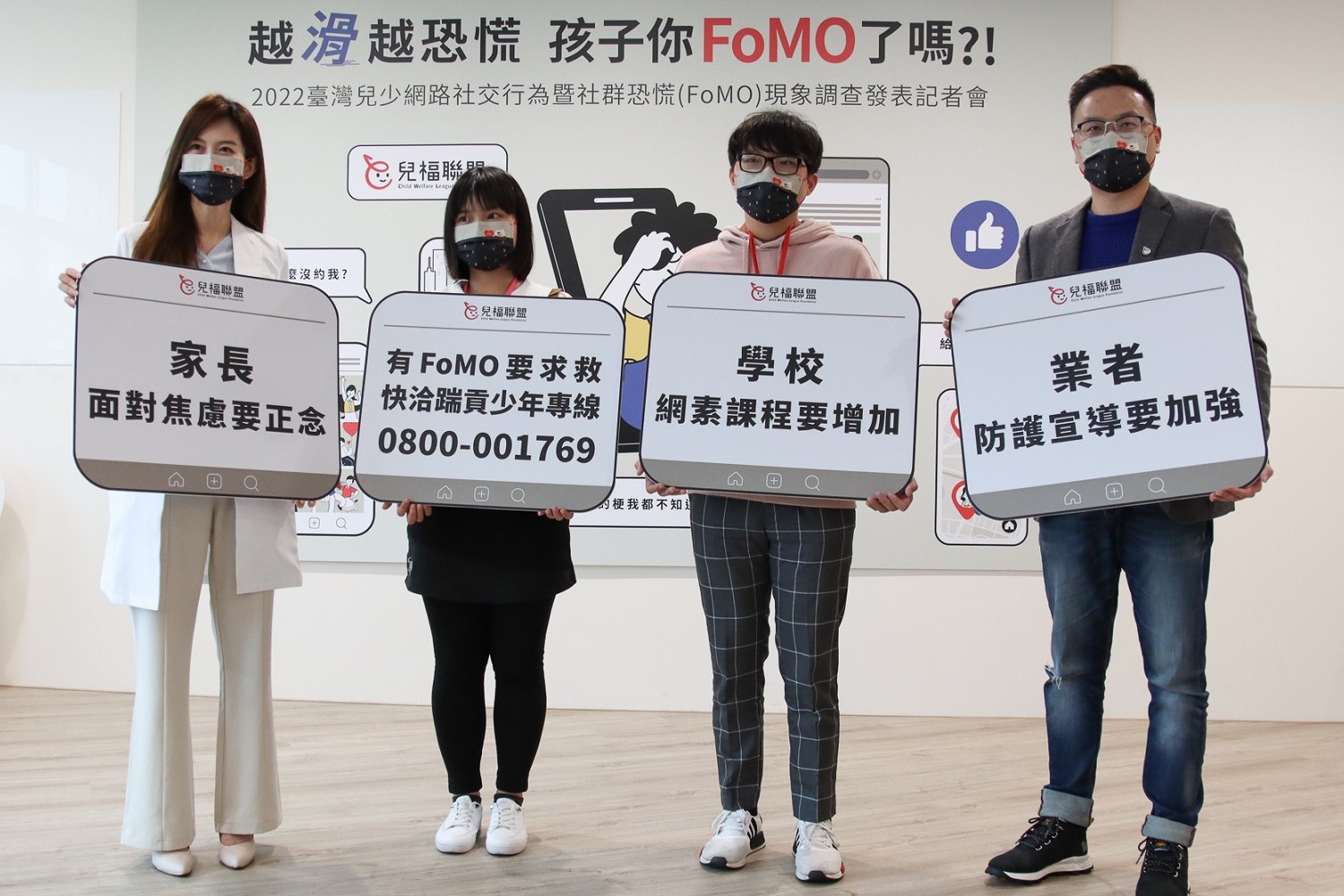
2022 Online Social Networking Behaviors of Taiwanese Children & Fear of Missing Out (FoMO) Survey
2022-02-22
Friends from the virtual world – real social networking fears?!
In this generation of rapidly growing 4G and 5G internet speed, ubiquitous cellphone use seems to be also satisfying the everyday needs of digital natives. Data research, doing homework, recreational use - even social networking exists in the virtual world. According to CWLF survey, 66% of the children believe that, “It’s easier to make friends over the internet than it’s in real life.” As making friends over the internet becomes easier, it has also intensified the children’s presence at online communities. Harold Lee, Senior Director of CWLF Advocacy Center, expressed his concern, “Even though the internet has expanded children’s horizon and social circle, over the long run, having social activities in the virtual world will lead to all kinds of internet safety concerns. According to our survey, there are more than one out of every four kids who have been asked by their internet friends to be in a relationship with them, meet up with them, even send them provocative photos or make other inappropriate requests. If children were not capable to make good judgment and reject inappropriate requests, their own personal safety would be at great risk…” In addition, the new concern of “Fear of Missing Out” (FoMO) derived from social networking has also made an impact on children’s physical and psychological development. While conducting our “Internet and Social Networking Behaviors of Taiwanese Children & Fear of Missing Out (FoMO) Phenomenon Survey”, CWLF noted that 86.9% of the children have already experienced one of the FoMO conditions, which is significantly higher than the percentage for the adults in the U.S. (in which the age group of 24-27 years old is mostly affected by FoMO with a percentage of 69%). The anxiety caused by FoMO will make someone constantly wanting to know about other people’s status, activity, and trapped in the mindset of comparing themselves with others. And these users, being afraid of missing any type of information, will also keep wanting to be in contact with the society or the public, as they repeatedly look up and increase usage of their social networking apps. Such insecurity has caused 23% of the children developed senses of loneliness, sense of inferiority, and other negative emotions.
In regards to the social networking apps loved by the children, besides the popular Messenger, Facebook, Instagram, etc., a new wave of popular social networking apps has also come forth. For example, from this survey, we have found this app called “Zenly”, which has become extremely popular amongst the young people; approximately one out of three students surveyed has downloaded and been using it (33.4%). This social networking app that has had children right in the stage of intensely valuing peer friendships rushing to download, but it has also put children’s privacy in danger or even brought them in the dilemma of whether to add their friends on the app or not. CWLF analyzes that once children with FoMO are in touch with Zenly, their anxiety, insomnia, and other negative emotions will be higher than those who are not using the app. Harold Lee said, “Also, in order to encourage users to invite their friends to join the platform, Zenly will attract users to add more friends by unlocking their Zenly’s functions or emoticons as reward to the increase of friends they add to the app. And it’ll also prompt the children to have more opportunities to be in touch with unidentified online friends. The survey has found that inappropriate requests to children by internet friends on Zenly (36.8%) nearly double the amount to other children who are not using the app (22%). It’s really worrisome for children who are yet fully grown to easily and helplessly fall into online safety traps.”
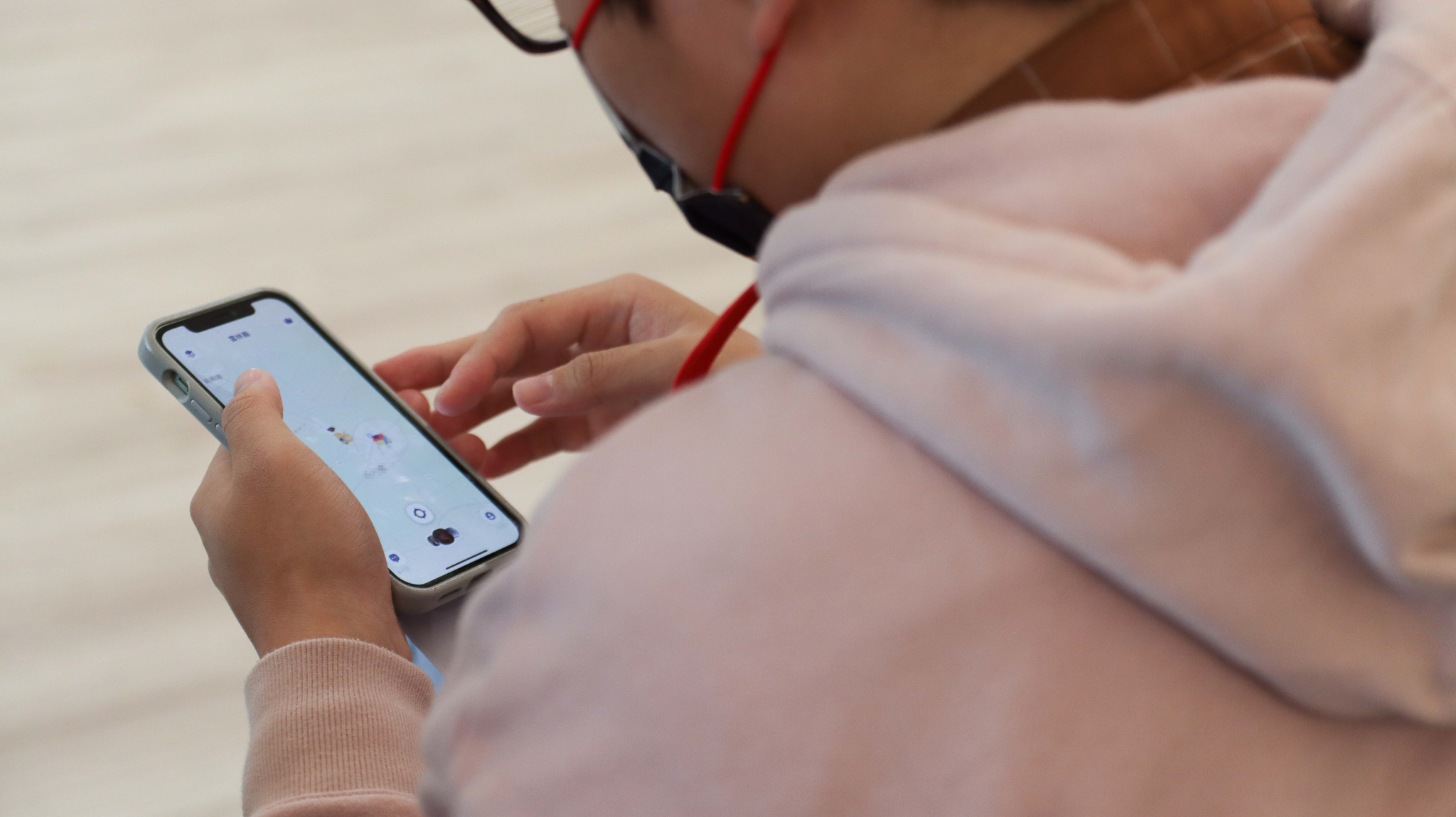
Functions of social networking apps are the key factors for children to choose their platforms, while excessive internet use also prompts incidents of inappropriate requests from online friends.
According to CWLF’s analysis of children’s use of online platforms, besides video streaming platforms, the most commonly used platforms are all of social networking nature; and they are Messenger (80.4%), Instagram (77.5%), Facebook (72.9%), and LINE (72.2%) respectively, all with higher than 70% usage rate. Ranked subsequently are the relatively new popular social platforms amongst children, e.g. TikTok (55.1%) and Zenly (33.3%). All various types of social networking apps have also further encouraged children to become more active in online social interactions. Per results of this research, 66.0% of the children believe that, “It’s easier to make friends online than it’s in real life.” In another words, two out of every three children are accustomed to make friends online. And as it becomes easier to make friends online, children’s internet use has thus also been intensified.
Increase of online social networking opportunities inevitably also puts children in higher internet security risks. As observed from our study surveying whether children have faced their internet friends making inappropriate requests, 26.5% of the children have experienced their online friends making inappropriate requests, which shows 6.3% increase as compared with 2020 (20.2%). Such significant increase in less than the two-year span presents a great concern. Looking specifically into all categories of inappropriate requests, the most commonly seen and rapidly growing incident is asking to be in a relationship (14.1%). Subsequently, they are the request for video call (13.1%), to meet one-on-one, and to provide personal information (9.9%). All categories of inappropriate requests have all increased as compared with the results from 2020 survey, which indicates that children’s online friends have made more requests and with more loosened boundaries. Once the children cooperate, these online friends only advance to make more requests; a grim outlook is posed for children’s personal safety.
Nearly 90% of children show signs of FoMO; one fifth of them feel lonely as a result.
Internet and real lives have been inseparable. The convenience of internet use has made it easier to gather information and to contact friends, but it may also cause FoMO, which is an anxious state where one would constantly want to know about other people’s status, activity, and trapped in the mindset of comparing with others. Moreover, people with FoMO will also maintain a mindset of wanting to stay connected with the society and the public; to prevent from missing any information or message, they will repeatedly check on their social networking apps and thereby increase their usage time on these apps. Per this survey, there are nearly 90% of the children (86.9%) who have shown one of the FoMO conditions. And comparing our results with a 2020 U.S. survey, where the age group of 24-27 years old is shown to be mostly impacted with 69% of them showing FoMO, it indicates that Taiwanese children’s FoMO percentage is dramatically higher as compared with the U.S. data. Amongst the FoMO conditions shown, the following aspects are what Taiwanese children mostly care about: “Understanding friends’ internet jokes is really important to me” (52.4%); “On my days off, I’ll keep following what my friends are posting on the internet.” (50.1%); and “I’ll be bothered if I’ve missed the chance to meet with my friends.” (48.3%) – which are all having around 50% of incidence rates.We have found in the survey that the severity of FoMO is related to children’s internet usage time. In another words, higher level of FoMO leads to longer internet use, which in turn will lead these users to believe that it is easier to make friends on the internet, and they will also encounter their internet friends making more requests. It is apparent that long-term reliance on internet social networking worsens the FoMO condition, and such vicious cycle will also impact children’s physical and mental health. The survey found that amongst the children with FoMO, nearly one fourth (23.0%) of them express that their own moods are affected; one fifth of them (20.0%) feel lonely; around 10% of them feel anxious (11.6%) or sad (11.1%). But when asked how they seek help, it is surprising to note that more than half (50.6%) of the children “choose not to do anything about it”. And even if they are willing to improve the conditions, they rarely proactively seek help from their parents (9.6%) or counsellors. They mostly choose to ask their classmates or friends (42.5%), or even internet friends (10.5%). The fact that children only seek help with their peers and internet friends when issues of their online social networking surface is also worrisome. In case when unfortunate incidents occur, who would be able to save these children and ensure their safety?
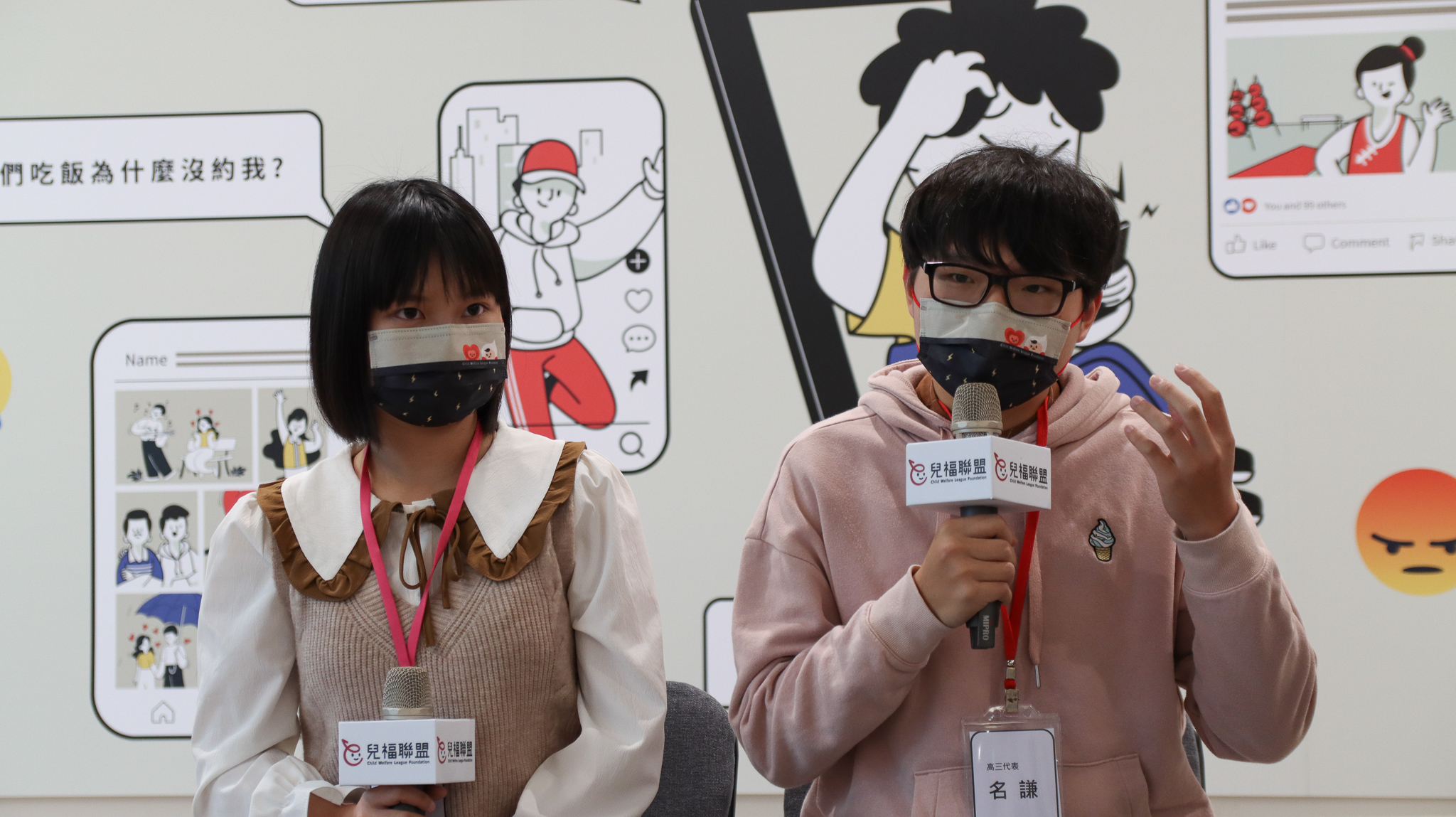
FoMO permeates across children’s new platform Zenly. Children forced to exchange friendship with their privacy; children’s whereabouts all exposed to unknown online friends.
According to the CWLF survey, the latest popular platform Zenly has attracted countless children to download – according to our survey, it is found that one third (33.3%) of them have downloaded and been using the app. This social networking app for cellphone is also nicknamed by the netizens as “Popsicle”, as the app has a popsicle icon. Its precise positioning function is able to display user’s location in real time to other users who are friends with the user. Friends are able to know the user’s moving route or even the user’s cellphone battery level and charging time. The app is also famous for being capable of accurately detecting friends’ everyday schedule and indicating whether a certain location is friends’ home or school. Children and their peers would also prove their friendship with one another by adding each other’s account to their Zenly. However, this kind of app, which offers no privacy, brings children into the dilemma of whether to add their friends, and greatly challenges children’s friendship, has also brought other concerns to the children’s lives.
CWLF analyzed that once children with FoMO start using Zenly, their anxiety, insomnia, and other negative emotions would also be much worse when compared with children who are not using the app. Moreover, as these children’s desire to be popular amongst their friends is higher as compared with other children, they would then crave to spend more time to browse and interact on the platform to find a sense of belonging. In addition, to stimulate users to invite their friends to join the platform, Zenly will attract users to add more friends by unlocking their Zenly’s functions or emoticons with certain amount of increase in friends they add to the app. Last year, a netizen on the Facebook group “Spill It 2 Community Group” had pointed out explicitly that he/she found it extremely scary when seeing many young children adding some friends of unknown backgrounds. CWLF’s survey also found that inappropriate requests made by internet friends, as experienced by children with FoMO using the Zenly app (36.8%), nearly double the amount experienced by other children who are not using the app (22%). Senior Director Harold Lee stated that, “Through Zenly, it has become more convenient for the children to track their classmates’ or friends’ status. However, the app does not only expose children’s home and school locations, but also their 24-hour everyday schedule. In the long run, stress of having no privacy and being monitored will surface. If the children choose to freeze or blur their locations, or even not to download the app, they would also experience the anxiety of being an outcast. And we also worry that there will be villainous netizens who would add children as their friends through Zenly, so that they would not only access children’s daily activities and locations, they would also directly reach the children face-to-face. Children’s lives seem to be a “Truman Show” that directly invites risks on the internet into their daily lives!”
At the press conference, two high school seniors were invited to share their experience of using social networking apps. Yun (nickname) downloaded Zenly as her friend invited her to do so, but later on, she found that many advertisers and strangers began sending her friend requests; Yun was appalled and quickly deleted the app. Many of her classmates and friends were all fanatic about using Zenly and would compete with one another on their friends’ count. And if a guy wants to add them as friends, they would also only add him if they think he is good-looking. Ming (nickname) also downloaded Zenly through invitation from his friend. Even though he had deleted the app once, he downloaded it back again later as his friends are all using it. Calling himself as a “heavy user”, Ming is browsing on the internet for 7 hours a day on average, and he is almost always online. When he has his cellphone in hand, he is almost always browsing the IG stories. Ming laughed as he said, “I always have to read all the stories before putting down my phone!” Ming said that he would feel a bit sad if he found out online that he had missed out on a trip with his friends.
Psychiatrist Min Shan Li shared her clinical case: Once a sixth-grade girl came to the clinic with her dad, and he pointed that his kid would keep chatting on her LINE groups till late at night, and it would even affect her performance at school on the next day. The girl would also easily have conflicts with the family; her parents had tried to cut off the internet at bedtime, but she would secretly connect to the neighbor’s internet. The parents had also tried to confiscate her cellphone, but the girl ended up buying a cellphone behind her parents’ back using the allowance she had saved. The situation had left this girl’s dad frustrated! Doctor Min Shan Li suggested that, if children are in constant need of their cellphone and would even tell lies just so that they could go on the internet; or show signs of anxiety, uneasiness, chest tightness, and mood instability, then they would need to seek professional assistance, as these children might be showing symptoms of FoMO.
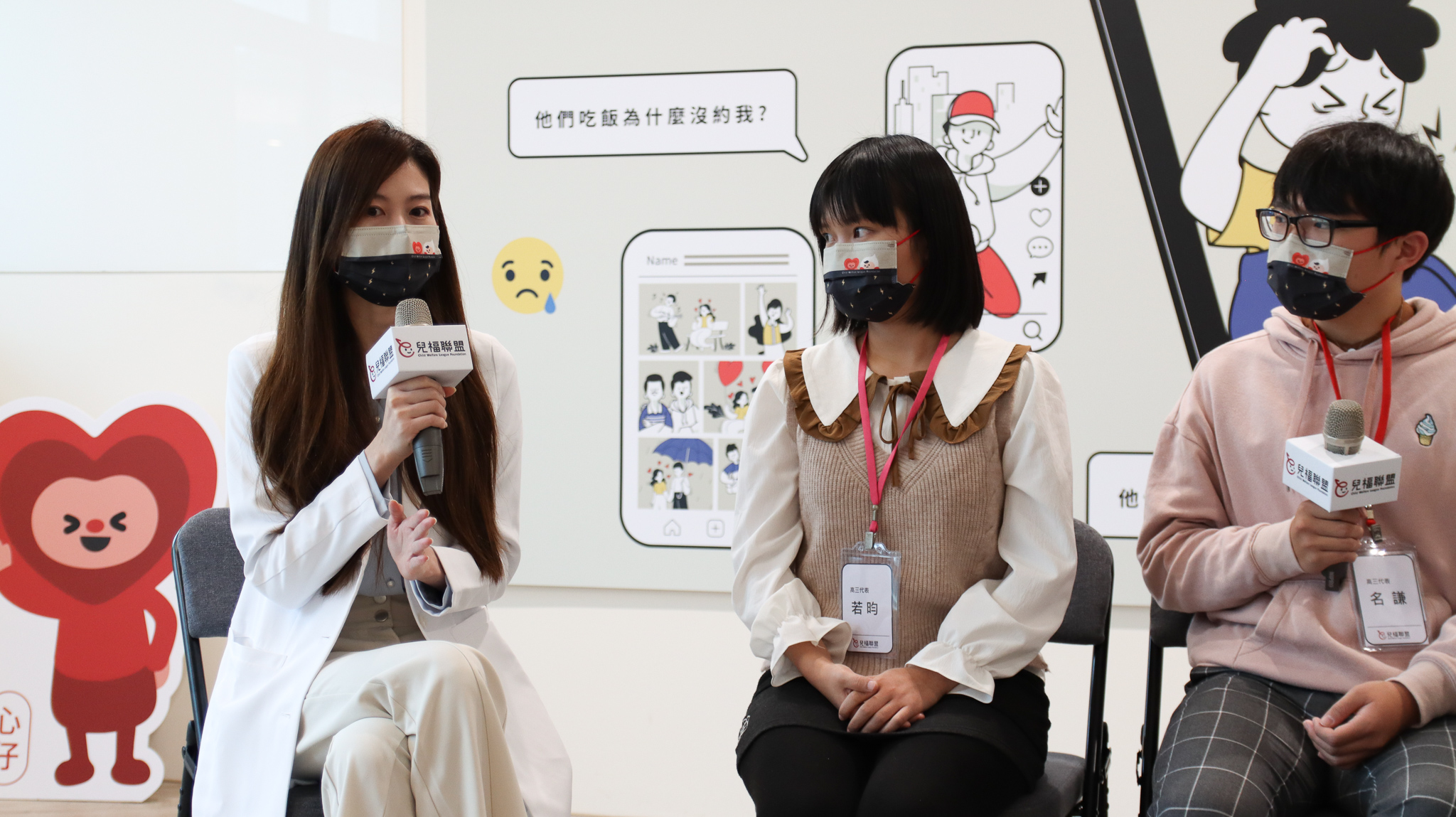
Lowering risks that the internet poses shall not only depend on children’s own precaution; platforms, schools, and parents shall all collaborate on offering protection with indispensable responsibility.
Have your children had FoMO? Senior Director Harold Lee stated that, “We’ve organized an internationally applicable FoMO test that is available for all parents and children to download and use, allowing them to develop self-awareness of their own internet usage and the impact their usage has brought upon them.” In addition, CWLF is also calling upon the platforms, parents, and schools to note the following:
1. Online social networking platforms shall provide warning message and notify channels available to offer help.
Social networking platforms such as Zenly are only prohibited to be used by children under 13 years old, but for child users between 14-17 years old, protections like displaying reminders when adding “unknown online friends” are not offered. Moreover, platforms shall provide and advocate for children’s help channels and reporting mechanism, so that children would be able to seek help when they encounter any issues during their use.
2. Schools shall reinforce on internet literacy education classes and become the reliable primary source for help.
Schools shall offer more internet literacy education classes for children so to reduce the risks the internet poses for children, as well as the impact that FoMO brings upon the children. It is recommended to use scenario-based education for the children to understand possible situations they may encounter online, to discuss internet usage etiquette, and to guide the children to manage appropriate balance of privacy and social networking. And most importantly, children need to know that regardless of the condition, school can be the most trustworthy safety net that is capable of assuming their worries.
3. Parents need to pay more attention to their children’s internet usage, and they shall collaboratively set forth rules on usage time.
Parents shall pay more attention on whether the children are exhibiting traits of and if are affected by FoMO; and they shall proactively prevent such incidents to take place. For instance, they could practice mindfulness with their children; through the practice, children would learn to stay calm and possess a steady mindset in response to the emotional impact that the internet may bring. Parents could also set forth a plan with their children, where they could discuss rules on internet usage time; it is recommended that they could use a software that could monitor individual’s everyday usage. Also, they could follow a workable plan that would reduce social networking app usage; cellphone alarm can be set, or the Pomodoro Technique can be used, to gradually reduce internet use.
4. Both parents and children need to examine internet use progress and seek professional assistance timely.
If children are frequently feeling anxious when using the internet, checking their cellphones and constantly updating content of their accounts, checking other people’s status, or even experiencing insomnia and affecting their daily lives, they could first obtain an initial assessment through the FoMO test (https://lihi1.cc/coLue) to see if there is a need to seek help. Children could also contact CWLF’s “Youth Helpline” at 0800-001769, or ask for comprehensive assessment from a doctor at any mental health clinic.
Many children express social networking anxiety when using location-tracking apps. Renowned illustrator Shaogao has worked with CWLF to publish location-tracking app response tips, hoping to provide children with some guidance. Please click on the following link https://reurl.cc/X4pVm7 for location-tracking app response tips.
